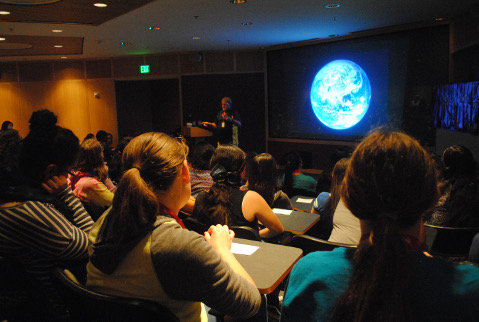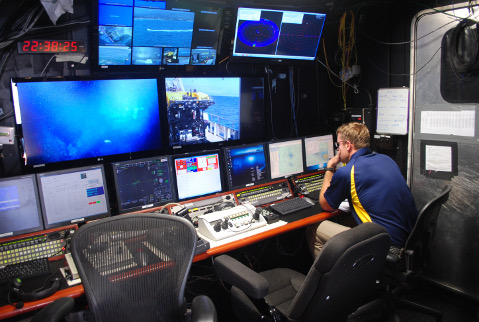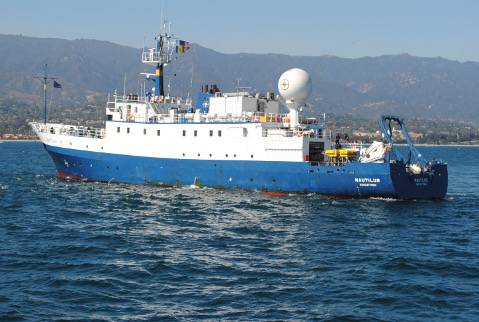Real-Time Exploring via E/V ‘Nautilus’
How to Dive to the Seafloor Without Getting Wet

The sperm whale’s bulbous head swam into focus on the video screen in UCSB’s Marine Science Research Building, and 76 eighth-grade girls fell silent. On campus in July for a science and engineering camp, they were seeing images from Robert Ballard’s E/V Nautilus voyage in 2015 to the Gulf of Mexico.

Excited voices tumbled from the speakers as the ship’s science team reveled in the rare encounter. For more than four minutes the majestic mammal circled the lights and cameras from two remotely operated vehicles (ROVs) nearly 2,000 feet deep in the Atlantic Ocean. The graceful visitor performed barrel rolls and inspected the robots, named Hercules and Argus, which had tickled its curiosity. Giddy laughter bubbled off the video soundtrack as the engineers, scientists, and interns on board documented the whale’s behavior.
“We come in peace,” drolly intoned one of the ROV operators, provoking a burst of laughter from the youthful UCSB audience. These women, participants in a weeklong Tech Trek camp that builds self-confidence through activities in science, technology, engineering, and math, had just glimpsed one of the wonders hidden below the ocean’s face. Biological gems from the Santa Barbara Channel, such as deep-sea corals, were also shared with the Trekkers who watched video of Hercules snipping fronds from the plantlike animals for laboratory analysis.
Last month Nautilus and its ROVs were stationed off Santa Barbara and Goleta to chart the floor of the Channel Islands National Marine Sanctuary (CINMS), half of which had never before been mapped. Sanctuary Superintendent Chris Mobley served as chief scientist for this leg of the ship’s four-month exploration of the West Coast. His staff played key roles on land and at sea before and during Nautilus‘s 19-day visit, since sharing discoveries is as important as making them.
Marine biologist Julie Bursek, coordinator of CINMS education and outreach programs, joined a Santa Barbara panel with Ballard, Mobley, and others to stir public interest. Afterward she was co-chief scientist on a side expedition to Point Conception. That trip’s main focus was to document resources needing protection in a proposed Chumash Heritage National Marine Sanctuary along the state’s central coast. By chance, they also came across a possibly new species of purple mollusk.

The ship’s unusual, interactive communications system, called telepresence, transmits audio and video in real time from the ship to online audiences most places the Internet operates. Depending on the setup, people can send questions to the ship by email or audio. Onboard science communicators, or those at the University of Rhode Island, a logistical partner for Ballard’s voyages of exploration, answer the public’s inquiries if they can. (As of this writing the purple mollusk still puzzles UCSB scientists.)
Telepresence provides the means for a series of public outreach events — the Tech Trek camp at UCSB is one example — and at local venues like the Santa Barbara Maritime Museum and the Natural History Museum. During the visit, Bursek reports, 57 live ship-to-shore “interactions” reached more than 525 students locally and in other states. A Facebook post with Ballard garnered 63,000-plus viewers.
If the Nautilus is online, anyone with an Internet connection can see and hear what the explorers are doing in the control room by going to nautiluslive.org and can send email queries to them at the same time.
“It’s incredibly powerful to have a live connection” to the ship, said Laura Francis, education coordinator for the sanctuary. She finds telepresence especially effective in stirring young people’s interest in ocean careers. At two interactions I attended, a number of people indicated new or renewed interest in marine biology. A lot of the credit goes to the Nautilus‘s science communication fellows.
One onboard science interpreter for the Santa Barbara Channel portion was Kate Standerfer, a San Marcos High School chemistry teacher who said she realized her “love for the ocean” at age 12. Tide pool life and dolphin behavior propelled her into a marine biology major at UCSB, followed by a master’s degree and teaching credentials in biology and chemistry in 2013.
“I became involved in the Nautilus program mostly by luck,” said Standerfer, alluding to a blast email she answered. It led to an unsalaried fellowship for educators that she felt was rewarding in terms of experience and adventure. “We [team members] still talk about the whale encounter,” she noted. For her, the different backgrounds, skills, and interests of the 30-member science team — specialists and interns rotate on each leg of the expedition while the professional crew of 17 is permanent — enriched the fellowship program.

In early August, when Standerfer left the ship, she already planned to apply for next summer’s voyage of exploration, though the mission itinerary had yet to be announced.
The Ocean Exploration Trust, the vessel’s legal owner, selects Nautilus program interns. Organizing data generated by the ship’s technology is their chief task, and Rhode Island University provides the training.
Goleta resident Eric Lindheim-Marx, a competitive swimmer and incoming senior at Dos Pueblos, presently is on board Nautilus as part of its Honors Research Program for outstanding high school students. He was trained as a “data logger” but also learned to build a drift device to track ocean currents.
His father, Robert, said that Eric heard about the program at the last minute but the long-time ocean devotee knew he must apply. “He only had three days to prepare [his entry],” his father said, including an essay he completed during rest time at a scheduled weekend swim meet.
This is the level of interest and dedication the multi-faceted Nautilus program seeks in recruiting interns and science team members. If interested in next year’s still-unpublicized voyage, go to the Ocean Exploration Trust website oceanexplorationtrust.org and click “Education” to check on qualifications.



